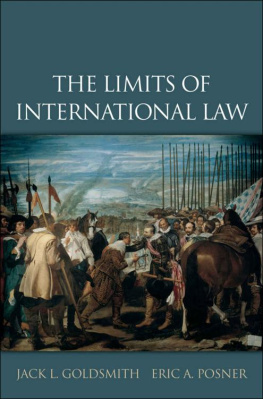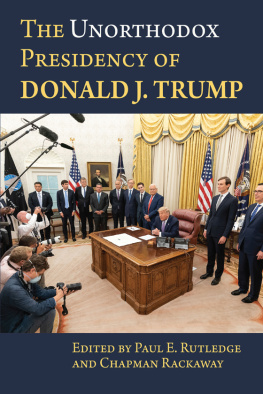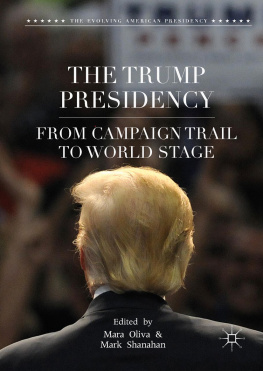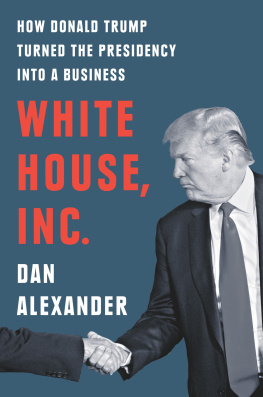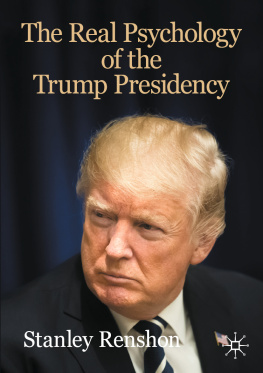AFTER
TRUMP
Reconstructing the Presidency
Bob Bauer and Jack Goldsmith
Lawfare Press / Washington, DC
Copyright 2020 Bob Bauer and Jack Goldsmith
All rights reserved. No part of this book may be reproduced in any form or by any electronic or mechanical means, including information storage and retrieval systems, without written permission from the publisher, except by a reviewer who may quote passages in a review.
Editorial production by Amy Marks
Cover design by Quenby Moone
Cover photograph by Abbie Rowe, National Park Service, courtesy Harry S. Truman Library & Museum
Cover copyright 2020 by Lawfare Institute
Lawfare Press
Lawfare Institute
P.O. Box 33226
Washington, DC 20033-3226
www.lawfareblog.com
@lawfareblog
Manufactured in the United States of America
Originally published in paperback and ebook by Lawfare Press in September 2020
ISBN: 978-1-7354806-0-2 (ebook)
Contents
For Anita and Leslie
PREFACE
It is Inauguration Day and the last day of the presidency of Donald Trump. Prompted by the chief justice of the United States, the president-electleft hand on the Bible, right hand raisedtakes the presidential oath prescribed by Article II of the U.S. Constitution: I do solemnly swear that I will faithfully execute the Office of President of the United States, and will to the best of my Ability, preserve, protect and defend the Constitution of the United States.
If it is January 20, 2021, the country will likely still be struggling with a global pandemic, vast economic dislocation caused by this public health crisis, searing national debates about racial injustice, and a deeply polarized political culture. If it is 2025, it is too far into the future to predict the course and effects of a second Trump term, or the then-prevailing political, social, and economic issues topping the national agenda.
But no matter when it happens, or who Trumps successor is, or what other issues demand attention, some of the most momentous and difficult questions the next president of the United States will face concern how to reconstruct the battered and much-changed presidency that Trump will have left behind.
Trump operated the presidency in ways that defied widely held assumptions about how a president might use and abuse the powers of the office. His mercurial personality, pathological mendacity, shamelessness, open disrespect for law and norms, vicious attacks on officials and institutions, intermingling of public and private interest, and indifference to facts did enormous damage to the great office that he assumed on January 20, 2017. And his words and actions exposed the presidencys vulnerability to dangerous excesses of authority and dangerous weaknesses in accountability. Trump was not the first president to raise these dangers, obviously, but he did so unlike any of his predecessors.
One of the most important things that the new president can do to faithfully execute the Office of President of the United States is to affirm and commit to the basic norms and institutional restraints that guided the presidency before Trump. This will likely be an extraordinarily challenging task, since the nation faces massive problems that demand vigorous government but might still be saddled with a Congress that in recent decades has proved feckless. The imperative for bold executive leadership will be strong. But as Arthur Schlesinger, Jr., taught, a constitutional Presidency [can] be a very strong Presidency as long as the president demonstrates that he has checks and balances incorporated within his own breast and understand[s] the legitimacy of challenges to his own judgment and authority. It will also be vital that the next president selects senior officialsespecially an attorney general and White House counselwho share these commitments.
But reconstructing the presidency will require much more than the right attitude by the president and senior executive branch officials. It will also require a comprehensive examination of the many fissures in the structure of the office that a future president might choose to exploit in a fashion similar to Trumpyet more skillfully and to greater effect. That examination, and proposals for the needed reconstruction of the presidency, are the aims of this book. These are admittedly immodest aims. Yet in the fourteen chapters that follow, we explain why broad reform is needed and propose more than fifty concrete changes to the laws, regulations, and norms that govern the presidency in what is the first attempt to think comprehensively about the proper shape of the post-Trump executive branch .
We begin in Part I by focusing on better protections against abuses of presidential power for personal and political gain. Part I proposes ways to counter the growing foreign state intervention in presidential campaigns, eliminate financial conflicts of interest, formalize tax disclosure requirements, prevent the executive branch from using its law enforcement tools to intimidate and retaliate against the press, and constrain misuse of the pardon power.
Part II focuses on the complex relationship between the White House and the Justice Department that is central to the rule of law in the United States. The problems here range from the danger of politicized prosecution, to deficiencies in the special counsel regulations, to inadequate guidance for FBI investigations of presidential campaigns and presidents, to the problem of a too-powerful White House counsels office.
Finally, Part III focuses on two issues where power has shifted significantly, and in our view excessively, from Congress to the president in recent decades: presidential discretion to use military force (including presidential control over nuclear weapons), and presidential control over vacancies in senior executive branch positions. It also briefly discusses other reforms that Congress and the new president should consider, including reining in some presidential emergency powers and adjusting the norms that should govern the examination of criminal allegations against a former president.
These reforms have no chance of being implemented while Trump is president. He wont embrace them, and it is doubtful that we will see a Congress capable of overriding his vetoes. This book is thus primarily about how to think about reform after Trump leaves the scene, whether that is in 2021 or 2025. Our primary aim is to spark informed debate about whether and how reform should proceed. We hope that the historical and legal background we provide in each chapter, the concise recounting of relevant events that transpired during the Trump administration, and our analysis of various reform approaches can be useful in the coming debates even if the reader is not convinced by our particular proposals or arguments.
We both served at high levels of government in the executive branch in two very different presidential administrations. Bauer was Barack Obamas White House counsel. Goldsmith served as George W. Bushs assistant attorney general in the Office of Legal Counsel. We have both written extensively on the presidency. We have both been supportive of presidential power in some contexts and critical of it in others. We are worried about the institution of the presidency, we believe reform is necessary, and we worry about the wrong types of reform. This book is our effort to frame the debate and strike the right balance.
CHAPTER ONE: RECONSTRUCTING THE PRESIDENCY




